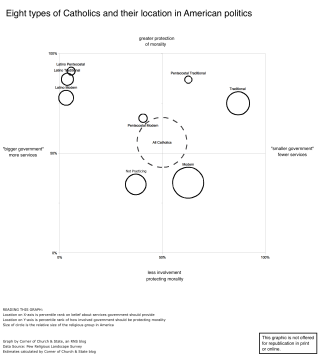This post updates our graph of the political ideologies of American churches and religion. See this post for the graph and further detail on how to read it.
One of the most notable features of last week’s graph religion and politics in the U.S. was the location of Catholics. Readers described it Catholics as being “dead center” or “bullseye.” On both economic policy and social policy, Catholics in the pews are, on average, in the middle of American politics.
Of course, one reason for the location of Catholics is that it is the church is, well, catholic. It is a both large and diverse. Keeping all Catholics together may be a valid decision, but it belies some important religious and political differences within the faith.
Getting to eight types of Catholics
 I’ve broken down Catholics into eight types. There’s no magic reason to have nine and not four, six, or a dozen. But these nine are based on several differences we find among American Catholics. In addition to the graph above, there’s a simplified version (click picture on the right) that shows just Catholics without other churches or religions.
I’ve broken down Catholics into eight types. There’s no magic reason to have nine and not four, six, or a dozen. But these nine are based on several differences we find among American Catholics. In addition to the graph above, there’s a simplified version (click picture on the right) that shows just Catholics without other churches or religions.
1. Practicing vs. Not Practicing Catholics
Some people are culturally Catholic but are not active in their religion. They were born (and baptized) Catholic and may have been raised Catholic. As adults, however, they do not participate in the life of a local parish. For my purposes, I used a low bar to place people into the “not practicing” category. Catholics who attend even a few times a year are, at least in this study, considered practicing.
2. Traditional vs. Modern Catholics
One of the challenges among Catholics is how to bring together the church’s tradition with modern life. Traditional Catholics are those who believe the Church should “preserve its traditional beliefs and practices.” In contrast, modern Catholics are those who believe that the church should “adjust” to modern life or even “adopt modern beliefs and practices.”
3. Latino Catholics vs. other ethnic Catholics
Latinos are one of the largest ethnicities within the American Catholic church. In many places, they are also one of the most recent immigrants. To be clear: not all Latino catholics are part of Latino congregations. Still, many are, and, for now, they represent a different flavor of Catholicism in America.
4. Pentecostal Catholics vs. other Catholics
Most pentecostals are evangelical Protestants, but there are also many Catholics who are pentecostal. Pentecostalism is a religious movement that emphasizing the active working of the Holy Spirit in the lives of Catholics, which believed to be manifest in miracles or speaking in tongues. Pentecostal Catholics often participate in services beyond the traditional mass, services that feature contemporary, energetic worship services. Pentecostal Catholics are a growing movement with the Church worldwide, just as they are within Protestantism.
Putting these four divisions together, I can identify eight types of Catholics in America:
- Not practicing
- Latino Pentecostal (includes both modern and traditional because of sample size)
- Latino Modern (does not include Pentecostals)
- Latino Traditional (does not include Pentecostals)
- Pentecostal Traditional (does not include Latinos)
- Pentecostal Modern (does not include Latinos)
- Traditional (does not include Latinos or Pentecostals)
- Modern (does not include Latinos or Pentecostals)
Observations from the graph
There’s a lot of information stuffed into this one graph, but here are a few key things we can see:
- Each of the three Latino Catholics types are located near each other, favoring more government services and greater protection of morality.
- Not Practicing Catholics are the most liberal, being left of center on both government spending and government protection of morality.
- Modern Catholics are the largest type. This groups holds a similar stance on social issues as Not Practicing, but is right of center on government spending.
- Traditional Catholics are the true conservatives — smaller government on economics but larger role on social issues.
- Pentecostals are more conservative on both dimensions than other Catholics. Modern Pentecostals are more conservative than other Catholics who want to adapt to modern life; Traditional Pentecostals are more conservative than other Catholics who are want to preserve tradition.
Geek note on measurement
The range of each dimension ranges from zero to 100. These scores were calculated by calculating the percentage of each religion giving each answer. The percentages were then subtracted (e.g., percent saying “smaller government” minus percent saying “bigger government”). The scores were then standardized using the mean and standard deviation for all of the scores. Finally, I converted the standardized scores into percentiles by mapping the standardized scores onto the standard Gaussian/normal distribution. The result is a score that represents the group’s average graded on the curve, literally.
Don’t miss any more posts from the Corner of Church & State. Click the red subscribe button in the right hand column. Follow @TobinGrant on Twitter and on the Corner of Church & State Facebook page.






